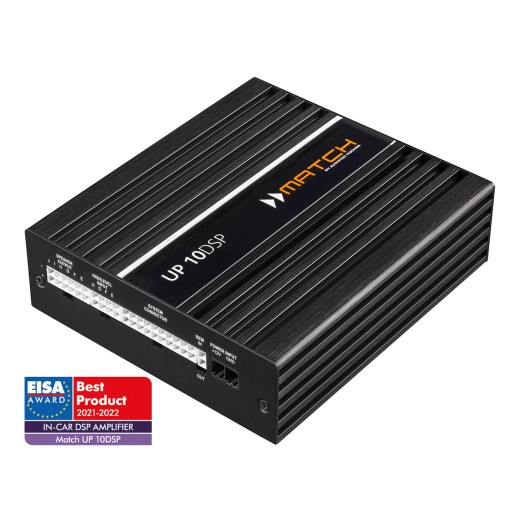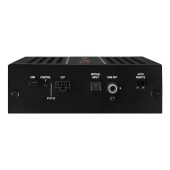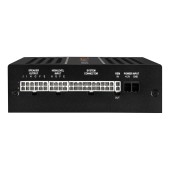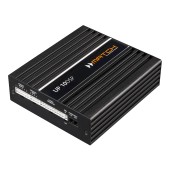Amplifier with DSP Match UP 10DSP ANALOG
More about the product
- Use our consulting room
- You can return the goods to us within 14 days
- Try the product at our store
Amplifier with DSP Match UP 10DSP ANALOG
UP 10DSP is the most powerful MATCH amplifier with integrated DSP. It contains new ADEP.3 circuits that ensure full compatibility with the latest car models. It offers a total of ten amplifier channels and additional preamplifier outputs, which, in combination with the integrated 11-channel DSP, allows you to perfectly control individual and complex audio systems. Two of the output channels deliver 160W RMS into 2 ohms - enough to drive even large subwoofers. Despite the concentrated power of 8 x 65 at 4 ohms and 2 x 90/160 watts at 4/2 ohms on the sub-out and the huge range of functions, the UP 10DSP comes in an extremely compact design, so it can be installed even in tight spaces. But brute force is nothing without "intelligent control" - that's why the UP 10DSP contains a high-performance 64-bit DSP of the latest generation, which enables the realization of completely new revolutionary and proprietary sound functions such as "Augmented Bass Processing", "StageXpander" or the "RealCenter" function. For optimal adaptation to existing multi-channel sound systems, the UP 10DSP is equipped with at least 8 high-level inputs (two of which can be loaded up to 32 V), an optical digital input, a MATCH expansion card slot, 10 amplifier outputs and a total of 11 processed DSP channels. In addition, intelligent technologies such as the proprietary ADEP.3 circuit and the 32-bit ACO platform ensure safe operation. Simply enjoy music from your smartphone in unprecedented quality. The UP 10DSP allows you to add several additional input and output interfaces, such as our Bluetooth ® Audio Streaming module or a High Resolution Audio USB sound card, via the MATCH Extension Card (MEC) slot. Thanks to our professional and user-friendly DSP PC-Tool V4 software, the configuration and setup of the UP 10DSP is quite simple and intuitive.
Maximum contact
For optimal adaptation to existing multi-channel sound systems, the UP 10DSP is equipped with at least 8 high-level inputs (two of which can be subjected to a high load of up to 32 V), an optical digital input, an expansion MATCH slot for a card, 10 amplifier outputs and a total of 11 processed DSP channels. In addition, intelligent technologies such as the proprietary ADEP.3 circuit and the 32-bit ACO platform ensure safe operation.
Virtual channel processing - this is how signal routing works today
Adaptation to modern factory sound systems makes increasingly complex signal routing in the amplifier inevitable, due to the increasing number of signal inputs. Conventional routing concepts quickly reach their limits, especially when multiple input signals are mixed together and then re-distributed into multipath systems. Audiotec Fischer's new, multi-stage "Virtual Channel Processing" in conjunction with the acclaimed user-friendly DSP PC-Tool software makes it possible to easily map even very complex system configurations and freely assign proprietary sound FX functions such as "RealCenter" or "Dynamic Bass Enhancement". But thanks to the enormous number of channels in conjunction with the optional MEC ANALOG IN module, the UP 10DSP is also a prime example for applications where 1:1 routing (IOR) makes sense.
Speed is everything - thanks to ACO
Such an enormous number of channels requires ultra-fast hardware – Audiotec Fischer's proprietary 32-bit ACO platform takes care of all control tasks and ensures high speed, especially for data communication with our DSP PC instrument software, but also for lightning-fast switching between up to ten possible sound settings. The fantastic sound effects associated with the ACO platform, such as Augmented Bass Processing, StageXpander or RealCenter, are as natural with the UP 10DSP as the 8-channel input EQ with Input Signal Analyzer (ISA) for easy analysis and compensation of input signals from OE radios.
Power Pack in a compact format
Despite the concentrated power of 8 x 65 at 4 ohms and 2 x 90 / 160 watts at 4 / 2 ohms at the subwoofer output and the huge range of functions, the UP 10DSP comes in an extremely compact design, so it can be installed even in tight spaces.
GD class technology
Audiotec Fischer's unique Class GD concept combines the advantages of Class G technology with the principle of a Class D amplifier. The result is an unusually high degree of efficiency, which again surpasses conventional Class D amplifiers. The advantages of the Class GD concept are manifested at low and medium modulation levels in that the internal the supply voltage of the power stages varies in degrees depending on the amplitude of the input signal. This drastically reduces the average power loss generated by the amplifier.
ACO - advanced 32-bit coprocessor
The MATCH UP10DSP amplifier uses a particularly powerful 32-bit co-processor of the latest generation for all internal and external control and communication tasks. Compared to the previously used 8-bit processor, this brings significant speed advantages, not only when switching between different sound settings, but especially in data communication with our DSP PC tool software. Another great advantage is the integrated native CoProcessor loader. The latter enables software upgrades of all DSP components, for example to adapt the ADEP.3 microcontroller-controlled circuit to changes in factory radio diagnostic systems in the future or to expand the device with additional interfaces. In addition, thanks to the new flash memory, the ACO offers space for 10 sound settings instead of the usual two.
Intelligent high-level input ADEP.3
Modern, factory-installed car radios are becoming more intelligent when it comes to diagnosing connected speakers. In particular, the latest generation is equipped with additional monitoring functions, so that when an additional amplifier is connected, error messages or even malfunctions may occur. The new ADEP.3 (Advanced Diagnostics Error Protection Generation 3) circuit prevents these problems without unnecessarily loading the radio's speaker outputs at high levels.
Start-Stop capability
The power supply in the UP10DSP amplifier provides internal power even in case of short-term drops of up to 6 volts. This ensures that the amplifier remains fully functional even when the engine is started. If the voltage on the board drops below 10.5 volts for more than 5 seconds, the amplifier will go into "Protect Mode" (status LED is solid red) to prevent further discharge of the battery.
Automatic digital signal detection
The UP10DSP enables signal-controlled switching between analog and digital input. As soon as an audio signal is detected at the optical input, the amplifier switches to this input. This function can be activated in the DSP PC-Tool software, or alternatively manual control can be chosen using the optionally available remote control.
Power saving mode
Power saving mode allows the UP10DSP (and any other connected amplifiers) to significantly reduce power consumption if there is no input signal for more than 60 seconds. When "Power Save Mode" is active, the UP10DSP's internal amplifier stages and the remote output are shut down, greatly reducing power consumption. The amplifier will return to normal operation within 2 seconds as soon as there is a music signal at its input. The switch-off delay can be changed or completely disabled using the DSP PC-Tool software.
RealCenter
The "RealCenter" function is Audiotec Fischer's proprietary algorithm that emphasizes the monophonic information of the left and right front channels to create a unique center signal. Unlike the usual method in which only the channels are summed, there is also dynamic control of the center signal through the stereo information content of the left and right channels. This means that the center channel does not reproduce the signal if only the left channel or only the right channel provides the audio signal. With the usual algorithms, the center channel would be only 6 dB quieter in this case. The "RealCenter" from Audiotec Fischer thus enables a unique, wide view of the stage - and that's ideal for both driver and passenger! The disadvantages of a conventional center channel, such as distracting, narrow spatial sound imaging, are finally a thing of the past.
Advanced bass processing
Audiotec Fischer's proprietary "Augmented Bass Processing", consisting of two revolutionary sound functions: "Dynamic Bass Enhancement" and "SubXpander". These are specifically designed to dramatically improve bass response from subwoofers. "Dynamic Bass Enhancement" ingeniously combines extremely deep bass and high maximum sound pressure - regardless of the type of music you're listening to or the sound settings on the radio. Depending on the input signal, "Dynamic Bass Enhancement" on the one hand boosts the lower frequency range and on the other hand changes the cutoff frequency of the subsonic filter. The result is significantly more powerful, deeper bass reproduction at low and medium volumes without the risk of mechanical or electrical overload of the subwoofer at high volumes. It's just fascinating what kind of bass performance is suddenly possible. If you want the bass range to be a bit deeper and "blacker", you can also activate "SubXpander". Here, additional subharmonic tones are added to the fundamental tones in the frequency range between 50 and 100 Hz.
StageXpander
Depending on the arrangement of the speakers in the vehicle, a more or less wide stereo stage can be created on the front seats. If a center speaker is also installed, sometimes this also limits the spatial reproduction of music. This is where the new Audiotec Fischer "StageXpander" comes into its own - a sound function that seems to remove acoustic boundaries, allowing for a significantly wider stereo base without negatively affecting the accuracy in the localization of voices or instruments. The effect can be adjusted according to personal taste in four stages.
ClarityXpander
Would you like more transparency and substance in high frequency reproduction? Audiotec Fischer now offers exactly the right tool for this with the "ClarityXpander". When properly dosed (and thus selectable in three stages), it adds extra radiance to the undertones, especially useful if the original speakers lack the necessary high-frequency sparkle. Extra high kick is not only available for the two front channels, but also separately adjustable for the center channel. And since, especially with the latter, in connection with musical material rich in aliquots, it is too much, tiring the ear, the automatic dynamic control of the additional aliquot component can even be activated here.
Key properties
- Highly efficient 10-channel amplifier with 1-channel line output and 11-channel DSP.
- Ideal for upgrading multi-channel factory sound systems.
- Optional wiring harnesses for easy integration into existing multi-channel factory sound systems.
- Extremely powerful 64-bit "Fixed Point" audio DSP.
- ACO - Advanced 32-bit coprocessor platform for system and DSP functions.
- ISA (Input Signal Analyzer) and InputEQ for easy analysis and compensation of input signals.
- Sound Effects SFX - Augmented Bass Processing, StageXpander, RealCenter & Co.
- High-performance 8-channel high-level input with ADEP.3 circuit - two of them have inputs with input sensitivity up to 32V RMS.
- 1-to-1 channel routing (IOR) capability in conjunction with the optional MEC ANA-LOG IN module - the same number of high-level inputs and amplifier channels.
- Virtual Channel Processing (VCP) enables even more flexible configuration of highly complex audio systems.
- MEC slot for system expansion such as Bluetooth® audio streaming, USB high definition audio streaming, etc.
- Optical SPDIF input with sampling frequency between 12 and 96 kHz.
- Mono cinch output for connecting other amplifiers, e.g. subwoofer amplifiers.
- SCP (Smart Control Port) for optional accessories like WIFI CONTROL, DIRECTOR, CONDUCTOR & Co.
- Automatic remote switch.
- Start-Stop capability up to a supply voltage of 6 volts.
- Extremely compact dimensions and low heat generation thanks to very high efficiency.
- Including MEC ANALOG IN module.
| Catalog number | UP 10DSP ANALOG |
| Brand | Match |
| Links | Official web presentation |
| Number of amplifier channelsAmplifiers are divided into: - Monoblocks - 2-channel - 3-channel - 4-channel - 5-channel - 6-channel - multi-channel Each channel is used to power one speaker for the coaxial type, or one side if they are component speakers. Monoblock type amplifiers are mainly used for subwoofers. 2-channel are suitable for both subwoofers and, for example, the front pair of speakers in a car. 3-channel is used for front or rear speakers + subwoofer. 4-channel are used for front + rear speakers or 1 pair of speakers + subwoofer. 6 or 5-channel are used for 2 pairs of speakers + subwoofer, most often. Bridging means connecting the amplifier to a bridge, using the + pole from one channel and the - pole from the other channel. In most cases this is shown as "BRIDGED" on the amplifier. | 10 |
| Energy class of the amplifierAmplifiers are divided into two basic classes: analog and digital . Analog amplifiers (A/B) have higher consumption requirements, but usually have a more natural sound. Digital amplifiers (D) have significantly lower consumption and higher efficiency, but the sound may not be as faithful as with classic analog amplifiers. | GD digital |
| RMS power into 4 ΩRMS power when loading speakers or subwoofer at 4 Ω. RMS power is the constant power of the amplifier and is one of the most important parameters when choosing an amplifier. | 8 x 65W |
| Integrated DSP processor | Yes |
| Number of DSP processor channels | 11 |
| Frequency rangeThe ability of the amplifier to reproduce the signal from the lowest frequency to the highest = faithfully reproduce the sound in a specific frequency band. Professionally: In the frequency range from 40 to 16,000 Hz, the vast majority of fundamental and overtones (harmonics) of all musical instruments are found. We are interested in the course of the radiated sound pressure in this range of frequencies when the loudspeaker system is supplied with constant power. We call this course the frequency characteristic, which tells us the level of radiated sound pressure in decibels (dB) depending on the frequency. The frequency characteristic of a speaker or speaker system can be expressed most succinctly with a graph. Mostly, however, the frequency characteristic is indicated by indicating the maximum tolerance of the sound pressure in the given frequency range, e.g. 50 to 15,000 Hz -+ 6 dB. Since the frequency characteristics of loudspeakers and systems in general are quite uneven, some manufacturers do not even specify this maximum tolerance of sound pressure in decibels in their catalogs for reasons of prestige. Data impoverished in this way is unfortunately worthless. What is valid is that the manufacturer offers a speaker system with a frequency range of 30 to 20,000 Hz, if he is worried about stating the maximum unevenness of the sound pressure in this range, because he can have a tolerance of, for example, +- 20 dB. The unevenness or undulation of the frequency curve in good speaker systems for high-quality music performance should not exceed +-3 dB in the 80 to 12,000 Hz band and +-6 dB in the 40 to 16,000 Hz band. Greater unevenness already depletes or emphasizes certain tonal areas, which can cause audible or even disturbing distortion. The proportion between fundamental tones and higher harmonics also changes, thereby changing the color of the sound, and individual musical instruments as well as the entire musical image sound unnatural. | 20 - 22000 Hz |
| Harmonic Distortion (THD)Total harmonic distortion indicates how much the input signal is distorted in the amplifier. Distortions appear as overtones contained in the output signal. The proportion of originally absent parts of the signal is given as a percentage, typical values are between 0.001% and 0.5%. Distortion is measured in their power band. If it exceeds the limit of 0.7% from a certain power, it is the value of the output power of the given amplifier, from which it no longer plays without distortion and from which the distortion usually increases steeply, so that no further increase in power can be counted on. The lower the value, the better. | < 0.03% |
| Signal-to-noise ratioThe signal-to-noise ratio means that the output signal always contains noise. The signal-to-noise ratio expresses how much of this noise is compared to the useful signal. The so-called A value is given, which does not take deep and very high frequencies into account. This corresponds to the characteristic of human hearing, which is not so sensitive to deep frequencies, especially below 1 kHz. The higher the value, the better the amplifier is. | 103 dB |
| Input sensitivityIn order for the amplifier to perform its function correctly, it requires an input signal of a certain level, which is different for car radios. It is measured in "Volts" (e.g. 2 V, 4 V, etc.) The higher the value at the output of the pre-amplifier, or car radio, the less demands are placed on the power of the amplifier. However, the amplifier must allow this input sensitivity, and for that reason this value is also given for the amplifier. | 10.5 - 17 V |
| Damping factorDF - Damping Factor . It is the ratio of the load (repro + cables, crossover, etc.) to the internal resistance of the amplifier. The bigger the DF, the more controlled the bass. Amplifiers with a lower DF tend to hum. Subwoofers with a higher Q in the bass reflex and sometimes in the enclosure will also cause humming. | > 100 |
| The value of the fuses on the amplifierFrom the value of the fuses on the amplifier, you can get a true picture of the real performance of the amplifier. | 2 x 25 A mini |
| Dimensions of the amplifier | 46 x 145 x 163 mm |






















